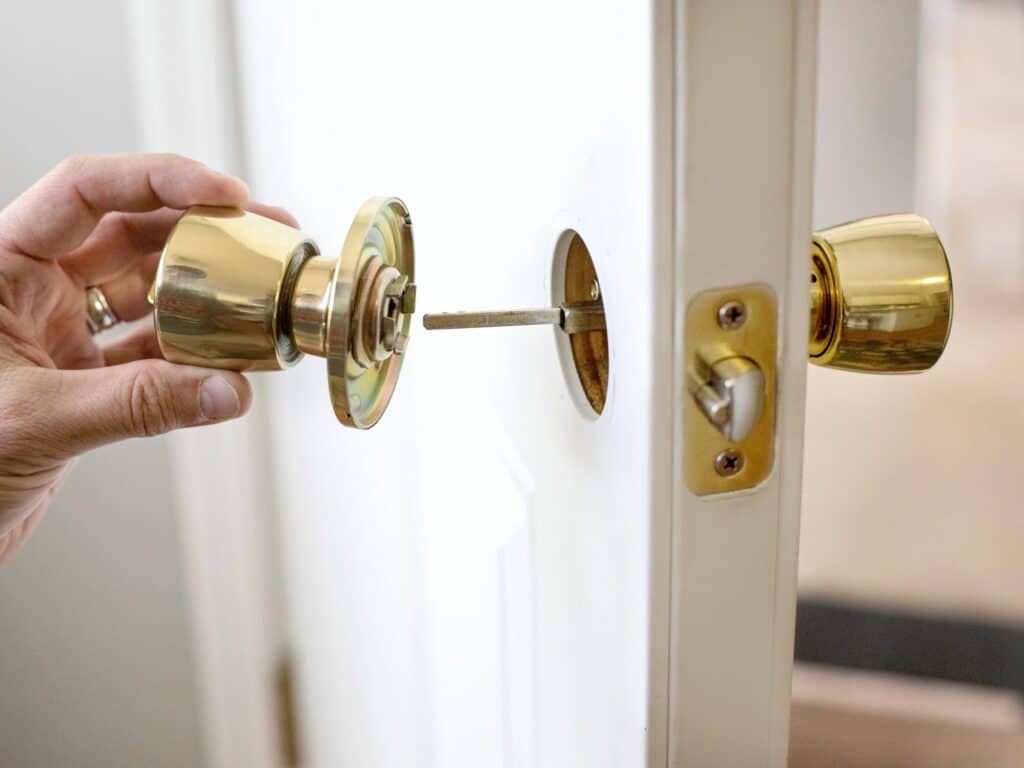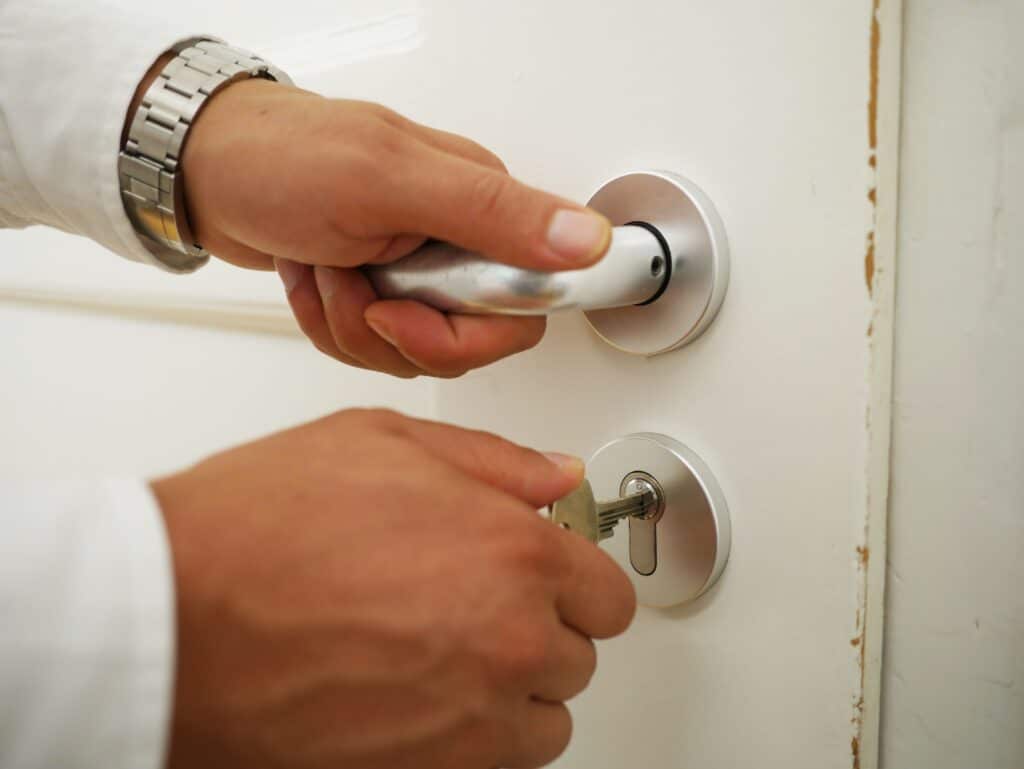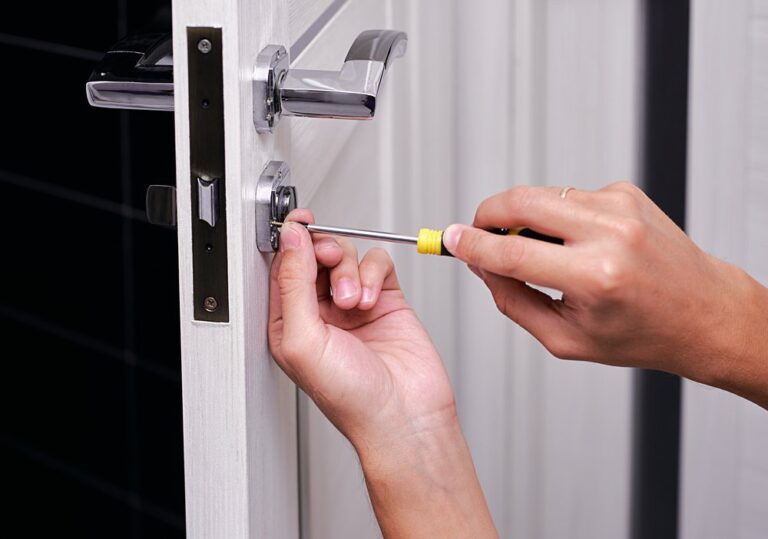Introduction
How To Fix A Door Lock Cylinder: A secure and functional door lock is essential for the safety and peace of mind of any homeowner or tenant. However, over time, door lock cylinders can become worn, damaged, or even malfunction, leading to security concerns and inconvenience. Easy door lock cylinder repair saves money and time. We will show you how to identify and fix common door lock cylinder faults in this tutorial, keeping your home safe and your life running smoothly.
Whether you’re dealing with a stubborn key that won’t turn, a lock code that doesn’t engage properly, or any other lock-related issue, this guide will provide you with the knowledge and techniques to tackle the problem effectively. So, let’s dive into the world of door lock repair and learn how to restore your peace of mind with a fully functional lock.
Fortunately, many concerns can be fixed without calling a locksmith or replacing the lock. Repairing a door lock cylinder is often possible with the correct knowledge and tools. We will show you how to identify and fix common door lock cylinder faults in this tutorial, keeping your home safe and your life running smoothly.
This post will teach you how to fix a stuck key, a non-engaging lock, or any other lock issue. We’ll detect the issue, disassemble and reassemble the lock, and offer recommendations and precautions.

How do you fix a spinning door lock?
If lubrication helps the lock work easier, but you still feel resistance when you turn the key, you should try using graphite powder in the keyhole. If it’s still not smooth and catching you may need to replace the mechanism or cylinder.
Worn Out or Broken Key: Over time, keys can wear down, especially if they are used frequently. A damaged or worn key may not properly engage with the lock’s pins and tumblers, leading to spinning.
Faulty Lock Cylinder: The lock cylinder itself can become damaged or worn out, preventing the key from turning properly. This can happen due to age, weather exposure, or excessive use.
Misaligned Door or Door Frame: A misaligned door or door frame can put extra stress on the lock mechanism, causing it to spin. This issue is often related to settling or warping of the door.
Loose Set Screw: Inside the lock mechanism, there is a set screw that secures the cylinder in place. If this screw becomes loose, it can result in the cylinder spinning freely.
Why is my lock not twisting?
Sometimes, dirt and dust can build up inside a lock, making it difficult. The locking mechanism to turn. Graphite spray or silicone-based lubricants can fix this problem. Applying the product and turning the key a couple of times.
Examine the Key:
Inspect your key for signs of wear, damage, or bending. If the key is the issue, have a new one made by a locksmith.
Lubricate the Lock:
Apply a lubricant designed for locks, such as graphite powder or a silicone-based lubricant. To the key and insert it into the lock. Turn the key several times to distribute the lubricant inside the lock cylinder.
Check for Door Misalignment:
Inspect the door and the strike plate for any misalignment. Adjust the door hinges or strike plate to align the door.
Thaw a Frozen Lock:
If the lock is frozen, use a de-icer or a hairdryer to melt the ice inside. Avoid using excessive force to prevent damaging the lock.
Is it easy to change a lock cylinder?
Lock cylinders can also be found in the ignition in most vehicles. If you want to change the key in your lock, it’s likely you’ll have to replace the lock cylinder. Luckily, doing so can be easy as long as you have the right tools and follow the right steps.
Ensure you have the appropriate tools and a replacement cylinder that matches your lock.
Begin by removing the door handle or knob, which usually conceals the screws holding the cylinder in place.
Use a screwdriver to remove any screws securing the lock cylinder in the door. Carefully detach the cylinder from the lock mechanism.
Insert the new lock cylinder into the same position as the old one, aligning the keyway properly.
Reattach any screws and ensure the cylinder is securely in place.
What is a 2 cylinder lock?
While the single-cylinder deadbolt only features a locking mechanism requiring a key on one side. The double-cylinder deadbolt has it on both. This means that a key will be required to turn the lock both on the inside of the door and the outside. This is the main difference between these two types of deadbolts.
Locking from the Outside: When you want to lock the door from the outside. You insert a key into the exterior cylinder and turn it clockwise. This action engages the locking mechanism, securing the door.
Unlocking from the Outside: To unlock the door from the outside, you insert the key into the exterior cylinder and turn it counterclockwise, disengaging the lock.
Locking from the Inside: From the inside, you use a key to lock the door by inserting it into the interior cylinder and turning it clockwise.
Unlocking from the Inside: To unlock the door from the inside, you again use a key in the interior cylinder, turning it counterclockwise to release the lock.
What lubricant for door locks?
Teflon-based Lubricants
Top of our list is PTFE lubricants. Polytetrafluoroethylene, or PTFE, is a Teflon-based lubricant that dries inside. The lock to leave behind a non-stick, water-repellent film on all the surfaces. Since it’s dry, it doesn’t attract dust or dirt.
Graphite Powder: Graphite is a popular and effective dry lubricant for locks. It comes in a powdered form and is often packaged in a small tube or squeeze bottle. Graphite powder is known for its ability to reduce friction without attracting dust or debris. Making it an excellent choice for door locks. It’s particularly suitable for both key-in-knob and deadbolt locks.
Silicone-Based Lubricants: Silicone-based lubricants are available in spray or liquid form. They are a versatile choice for locks as they provide long-lasting lubrication. Resist moisture, and offer protection against rust and corrosion. These lubricants are safe to use on a wide range of lock types, including outdoor locks exposed to the elements.
Teflon-Based Lubricants: Teflon-based lubricants, like silicone-based ones, are available in spray or liquid form. They offer excellent lubrication, are non-sticky, and provide resistance to moisture and corrosion. Teflon lubricants are suitable for a variety of locks, including automotive locks.
Why wont my door close all the way?
Check Your Hinges
If the latch is too high or too low, try tightening your door’s hinges. If your door still won’t close after that, remove one of the screws on the jamb side of the hinge and drive in a 3-in. screw–it will help pull in the whole doorjamb.
Preparation: Begin by cleaning the lock’s exterior with a clean, dry cloth to remove any dirt or debris. Ensure the keyhole is clear.
Graphite Powder: For graphite powder, insert the nozzle into the keyhole and squeeze a small amount of powder inside. Insert and remove the key several times to distribute the lubricant. Wipe away any excess powder from the lock’s exterior.
Spray or Liquid Lubricants: For spray or liquid lubricants, apply a small amount directly into the keyhole and along the key’s blade. Insert and remove the key multiple times to work the lubricant into the lock. Wipe away any excess from the lock’s exterior.
White Lithium Grease: For white lithium grease, apply a small amount directly to the lock’s moving parts, including the bolt and latch. Work the grease into the mechanism using a key or by manually operating the lock. Wipe away excess grease.
What is the most common lock cylinder?
A “single” cylinder lock is operated from the outside with a key, and from inside with thumb-turn. One can secure the door from inside, as well as exit the house without a key, making this the most popular option.
Key Pins and Driver Pins: A pin tumbler cylinder consists of a series of key pins and driver pins stacked in a precise arrangement. When the correct key is inserted. The key pins align with the shear line. Allowing the cylinder to turn and unlock.
Shear Line: The shear line is the gap between the key pins and driver pins. Inserting the key raises the key pins to match the shear line, rotating the lock.
Variety of Key Shapes: Pin tumbler cylinders can be customized to fit a variety of key shapes and profiles for security.
Rekeyable: One of the key advantages of pin tumbler cylinders is their rekeyable nature. Locksmiths and property owners can easily change the lock’s key combination by replacing the pins, making it a cost-effective choice for security updates.
What is a core cylinder?
A cylinder refers to the complete unit of a housing + core. A core refers to the inner part of the cylinder that contains the pins and receives the key. A housing refers to the part of the cylinder that holds the core inside of it.
Pin Tumbler Core Cylinder: This is the most common type of core cylinder, as discussed in a previous response. When the right key is inserted, key and driver pins align along a shear line to turn the lock.
Wafer Tumbler Core Cylinder: Wafer tumbler cylinders use flat wafers instead of traditional pins. Inserting the right key spins the cylinder, aligning the wafers in each stack along a shear line.
Tubular Core Cylinder: High-security locks feature tubular core cylinders with circular keys and pins around the center. Pins align to rotate when the key is turned.
Disc Detainer Core Cylinder: Disc detainer cylinders feature a series of discs with notches and false gates. The lock turns when the key contacts with the notches, but false gates stop erroneous keys.

Conclusion
DIY solutions to lock cylinder problems are common, but security should always come first. If you encounter a particularly challenging issue or are uncomfortable with any aspect of the repair, don’t hesitate to seek professional assistance.
By maintaining your door locks and addressing issues promptly, you can enjoy peace of mind, knowing that your home is secure, and your daily life runs smoothly. This article has given you the tools and information to fix your door lock cylinder and ensure the safety of your home.
Furthermore, taking the time to understand your door lock cylinder and how it operates can lead to better overall security awareness. You’ll have a deeper appreciation for the importance of regular maintenance and the significance of investing in high-quality locks for your doors.
In a world where security is a top priority, knowing how to fix a door lock cylinder is a practical skill that not only enhances your home’s safety but also boosts your self-reliance. So, as you embark on your journey to become a DIY door lock expert, remember that the benefits extend beyond the immediate repair – you’re building confidence and a more secure living environment.

